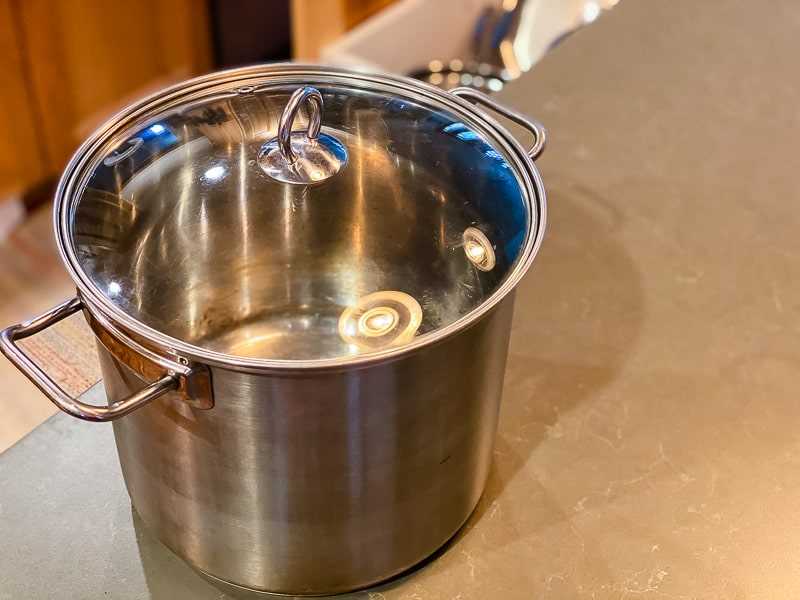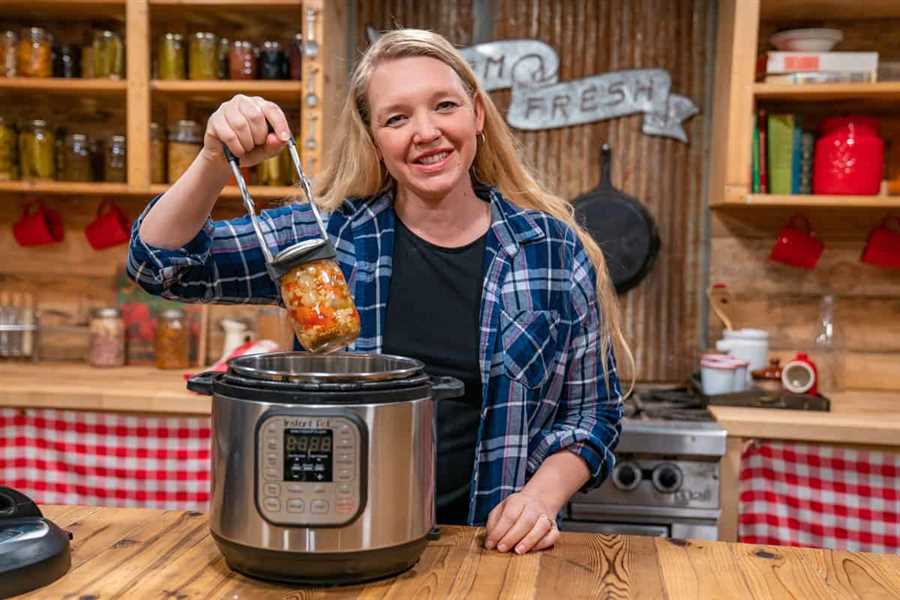



When it comes to cooking, having the right equipment is essential. A canning pot is typically used for the process of preserving food in jars, but can it be used for regular cooking as well? The answer is yes, but with some considerations.
A canning pot is designed to hold large volumes of water and maintain a steady temperature, which makes it ideal for canning purposes. However, it can also be used for other cooking methods such as boiling pasta, making soups or stews, or even deep-frying.
One important thing to note is that most canning pots come with a removable rack that is used to hold the jars during the canning process. This rack can be removed when using the pot for cooking, allowing you to use the full capacity of the pot for larger batches of food.
It’s worth mentioning that using a canning pot for regular cooking may cause some wear and tear on the pot, especially if it’s made of aluminum. Over time, the constant exposure to heat and other cooking processes may affect the integrity of the pot.
Benefits of using a canning pot for cooking
Using a canning pot for cooking offers several benefits that make it a versatile tool in the kitchen. Here are some of the advantages:
1. Efficient heat distribution: Canning pots are designed to distribute heat evenly, ensuring that your food cooks evenly. This means that you won’t have to worry about hot spots or uneven cooking.
2. Large capacity: Canning pots are typically larger than regular cooking pots, allowing you to cook larger quantities of food at once. This is especially useful when you are cooking for a large group or preparing meals in advance.
3. Versatility: Canning pots can be used for various cooking methods, including boiling, simmering, and steaming. They are perfect for making soups, stocks, stews, and sauces. You can also use them for canning fruits and vegetables or preparing homemade jams and preserves.
4. Durability: Canning pots are made of sturdy materials such as stainless steel or enamel-coated steel, making them durable and long-lasting. They can withstand high temperatures and can be used on different types of stovetops.
5. Convenience: Canning pots often come with a fitted lid and a wire rack, which makes them convenient to use. The lid helps to trap heat and flavors, while the wire rack allows you to lift the jars in and out of the pot safely.
6. Cost-effective: Investing in a canning pot is a cost-effective solution, especially if you frequently cook large batches of food or are into canning. It eliminates the need for buying multiple pots and pans, saving you money in the long run.
Overall, using a canning pot for cooking can enhance your culinary experience by providing efficient heat distribution, versatility, and convenience. It is a practical and economical tool that every home cook should consider adding to their kitchen arsenal.
Types of canning pots for cooking
When it comes to canning, having the right pot is crucial for successful cooking and preservation. There are several types of canning pots available for this purpose, each with its own set of features and benefits. Here are a few popular options to consider:
1. Water Bath Canner:
A water bath canner is a large, deep pot with a removable rack that sits at the bottom. It is specifically designed for high-acid foods such as fruits, jams, jellies, and pickles, which can be safely canned using the boiling water method. The rack helps ensure even heat distribution and allows for easy removal of processed jars.
2. Pressure Canner:
Unlike a water bath canner, a pressure canner is used for low-acid foods such as vegetables, meats, and soups. It is equipped with a locking lid and a pressure gauge, allowing it to reach and maintain high temperatures needed for safe canning. Pressure canners come in both dial-gauge and weighted-gauge varieties, providing flexibility for different recipes and altitudes.
3. Multi-Purpose Canner:
A multi-purpose canner is a versatile option that can function as both a water bath canner and a pressure canner. It typically comes with a removable pressure canning lid, allowing you to switch between the two methods depending on the recipe you are working with. This type of canner is ideal for those who want the convenience of two canning methods in one pot.
4. Electric Canner:
For those who prefer a more automated canning process, an electric canner is a popular choice. It functions similarly to a multi-purpose canner but with the added benefit of built-in temperature control and timers. This makes it easier to regulate the canning process and reduces the need for constant monitoring.
Overall, the type of canning pot you choose depends on the types of foods you plan to can and your preferred canning method. Regardless of which pot you use, always follow proper canning guidelines and recipes to ensure the safety and quality of your preserved foods.
How to choose the right canning pot for cooking

When it comes to canning, having the right equipment is essential for a successful and safe process. One of the most important pieces of equipment you’ll need is a canning pot. A canning pot is a large, deep pot with a tight-fitting lid that is specifically designed for canning. It is used for boiling the jars of food to create a seal and preserve the contents.
Here are some factors to consider when choosing the right canning pot:
Size: The size of the canning pot you choose depends on the amount of food you will be canning. A larger pot is ideal if you plan on canning in large quantities, while a smaller pot is sufficient for smaller batches.
Material: Canning pots are typically made from stainless steel or enamel-coated steel. Stainless steel is durable, easy to clean, and does not react with acidic foods. Enamel-coated steel is also a good option as it prevents the pot from rusting and provides better heat distribution.
Shape: Canning pots come in different shapes, including straight-sided and tapered. Straight-sided pots allow for easier insertion and removal of jars, while tapered pots allow for better water circulation during the canning process.
Features: Look for a pot with a rack or a built-in mechanism for lifting jars in and out of the pot. This will make the process safer and more convenient. Also, consider a pot with a flat, heavy bottom to ensure even heat distribution.
Compatibility: Make sure the canning pot you choose is compatible with your stove type. Some pots are not suitable for induction stovetops, so check the product specifications before making a purchase.
By considering these factors and choosing the right canning pot, you’ll be well-equipped to embark on your canning adventures and enjoy delicious home-preserved foods for months to come.
Safety precautions when using a canning pot for cooking

When using a canning pot for cooking, it is important to follow certain safety precautions to ensure your well-being and the well-being of others. Here are some important safety tips to keep in mind:
| Safety Precautions |
|---|
1. Properly clean and maintain the canning pot:
|
2. Use the canning pot on a stable surface:
|
3. Handle the canning pot with care:
|
4. Follow proper canning procedures:
|
5. Allow the canning pot to cool down safely:
|
6. Store the canning pot properly:
|
By following these safety precautions, you can enjoy using your canning pot for cooking while minimizing the risk of accidents or injuries.
Recipes that can be made using a canning pot
- Homemade jam: Use your canning pot to sterilize the jars and lids, and then use it to cook the fruit and sugar mixture for delicious homemade jam. This is a great way to preserve the flavors of your favorite fruits.
- Pickles: Make your own pickles using cucumbers, vinegar, and spices. Use the canning pot to sterilize the jars and lids, and then cook the brine mixture to seal in the flavors.
- Tomato sauce: Cook fresh tomatoes, onions, garlic, and herbs in your canning pot to make a delicious homemade tomato sauce. You can then use the pot to process and seal the jars for long-term storage.
- Soup or stock: Make a large batch of soup or stock in your canning pot and preserve it for future use. You can can the soup or stock in jars, allowing you to enjoy homemade soup even when fresh ingredients are not readily available.
- Fruit pie filling: Prepare your favorite fruit pie filling and use the canning pot to process and seal the jars. This way, you can enjoy a homemade fruit pie any time of the year.
- Applesauce: Cook apples with sugar and spices in your canning pot to make a delicious homemade applesauce. You can then preserve the applesauce in jars for later enjoyment.
- Peaches in syrup: Use your canning pot to blanch and peel fresh peaches, and then cook them in a sugar syrup to preserve their sweetness. Canning peaches in syrup allows you to enjoy the taste of ripe peaches year-round.
These are just a few examples of the recipes that can be made using a canning pot. Get creative in the kitchen and explore different preservation techniques to enjoy the taste of homemade foods all year long.
Questions and answers
Can you cook in a canning pot?
Yes, you can cook in a canning pot. Canning pots are designed for high heat cooking and can be used for a variety of cooking methods such as boiling, simmering, and steaming.
What can I cook in a canning pot?
You can cook a variety of dishes in a canning pot, such as soups, stews, pasta, vegetables, seafood, and even canning fruits and vegetables. The large capacity of a canning pot makes it great for cooking in large batches.
Is a canning pot good for deep frying?
No, a canning pot is not suitable for deep frying. Canning pots are usually made of thin aluminum or stainless steel, which may not be able to withstand the high temperatures required for deep frying. It is best to use a pot specifically designed for deep frying.
Can I use a canning pot to cook on a gas stove?
Yes, you can use a canning pot to cook on a gas stove. Canning pots are compatible with gas stoves and can distribute heat evenly for efficient cooking. Just make sure to use a canning pot with a flat bottom that can sit securely on the stove’s burner.
Can I use a canning pot in the oven?
No, it is not recommended to use a canning pot in the oven. Canning pots are typically not oven-safe as they are designed for stovetop use only. Using a canning pot in the oven may result in damage to the pot or uneven heating.
Can you use a canning pot for cooking?
Yes, a canning pot can be used for cooking. It is a large pot with a lid that is typically used for processing jars of food in a water bath canner. However, it can also be used for other cooking purposes like boiling large quantities of pasta or making soups and stews.
What are the benefits of using a canning pot for cooking?
Using a canning pot for cooking has several benefits. Firstly, it is designed to hold large quantities of food, making it ideal for cooking for a crowd or for preserving food in jars. Secondly, the tall sides of the pot help prevent splattering and spills. Additionally, many canning pots come with a rack that can be used for draining pasta or steaming vegetables. Finally, the thick bottom of a canning pot helps distribute heat evenly, preventing hot spots and ensuring even cooking.







